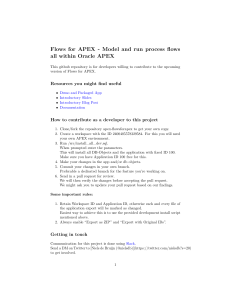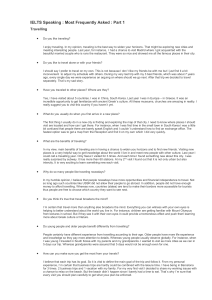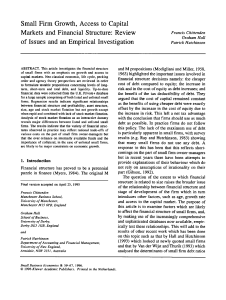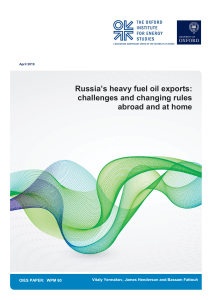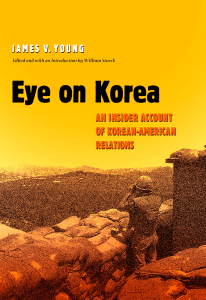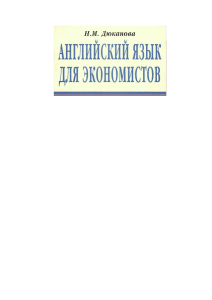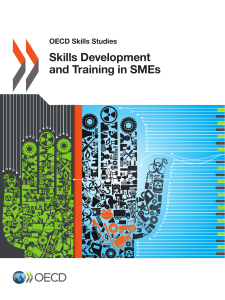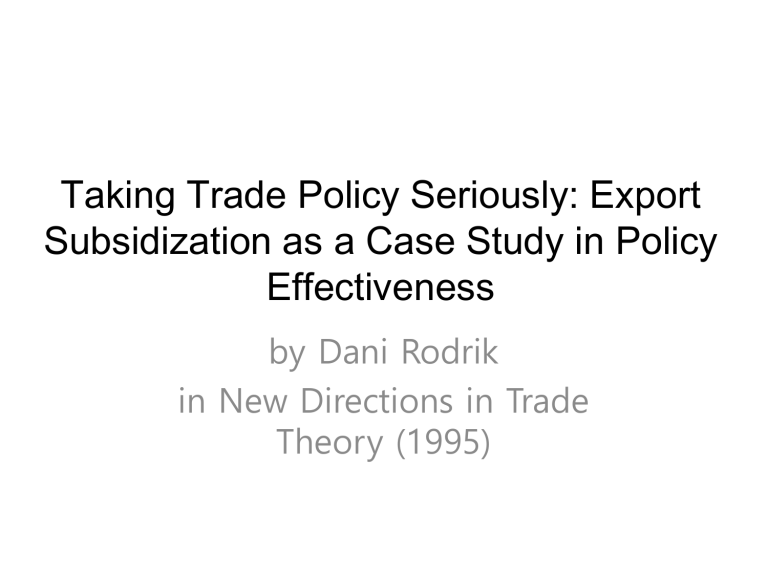
Taking Trade Policy Seriously: Export Subsidization as a Case Study in Policy Effectiveness by Dani Rodrik in New Directions in Trade Theory (1995) Introduction • In many of the standard models of trade policy, the government is viewed as omniscient and omnipotent, achieving any desired result with the stroke of a pen. These models obviously demand too much of the government. Their policy conclusions can be easily weakened (and sometimes reversed) by considering informational asymmetries or alternative strategic assumptions. Introduction • Trade economists are also skeptical regarding the ability of governments to act in the common good, rather than as an instrument of special interests. Krugman (1993, p. 364): “The broad argument for free trade, to which many economists implicitly subscribe, is essentially political: free trade is a pretty good, if not perfect policy, while an effort to deviate from it in a sophisticated way will probably end up doing more harm than good.” Introduction Grossman (1987, p. 65): “the market failures in the political realm might easily outweigh those in the economic realm, leaving us with a set of strategic trade policies that would serve only the interests of those fortunate enough to gain favor.” Introduction • The presumption that states lack the capacity to deliver appropriate policies may be correct in most contexts. But it may also be false! • A more appealing starting point is to grant that there exists such a thing as “state capability,” that some states may be adequately endowed with it, that other may not be, and that state capabilities can sometimes be enhanced where they are lacking. This broadened perspective may then allow us to use economists’ tools to attempt to understand when policy is effective (i.e., it produces the intended result) and why. • Focus of this paper: export subsidization. Preliminary Considerations • Three sets of economic models invaluable in thinking about policy formulation and implementation: (i) models of dynamic inconsistency of policy; (ii) models with irreversibilities and hysteresis; and (iii) models of rent seeking. 1. Dynamic inconsistency of policy: The basic model points to the costs of discretionary behavior by government officials and brings out the advantage of rulebased policy regimes which entail high degrees of precommitment. Preliminary Considerations 2. Irreversibilities and hysteresis: These models demonstrate the importance of policy stability, or more accurately, predictability in coaxing the desired response from the private sector. 3. Rent seeking: Policies that create rents will also create rent seekers. This in turn generates incentives for bureaucrats to create rents in the first place, leading to situations where rent-seeking interest groups and rent-providing policy makers interact to produce inefficient policy configurations. Thus, policy interventions should be avoided as a rule, but if they cannot, they should be undertaken in a manner that keeps private groups at arms length. Preliminary Considerations • Successful government programs are therefore likely to contain the following characteristics: 1. They apply simple and uniform rules, rather than selective and differentiated ones. 2. They endow bureaucrats with few discretionary powers. 3. They contain safeguards against frequent, unpredictable alteration of the rules. 4. They keep firms and other organized interests at arms length from the policy formulation and implementation process. Preliminary Considerations • But when looking at export subsidization, these broad conclusions have more explanatory power when turned upside down! Two most successful programs of export subsidization (South Korea and Brazil) were highly complex and selective, differentiated by firm, were subject to frequent changes, gave bureaucrats enormous discretionary powers, and entailed close interaction between bureaucrats and firms. Two least successful programs (Kenya and Bolivia) consisted of simple, across-the-board, and non-selective subsidies. Preliminary Considerations • Two concepts useful in characterizing differences in outcomes across countries: 1. State autonomy: The degree to which the state and administrative apparatus of a society is insulated from organized private interests and, consequently, can exercise discipline over them. 2. Policy coherence: A clearly articulated, stable, and nonconflicting set of policy priorities. Preliminary Considerations • Evidence from six case studies suggests: Policies work best when autonomy and coherence are both present; they fail when neither is. Policy coherence on its own is worth something: coherent programs can be successfully formulated and implemented even when autonomy is lacking, but at the cost of some abuse. Preliminary Considerations • “Soft states” (i.e., they ask very little of their citizens and are incapable of eliciting compliance when they try) vs. “strong states” or “hard states” (e.g., Jones and Sakong, 1980, locate the key to South Korea’s stellar economic performance in the presence of a “hard” state). • Think of autonomy as the extent to which the state can act as a Stackelberg leader over private groups (strong state), rather than as a Stackelberg follower (weak state). Preliminary Considerations • The aforementioned conclusions regarding what constitutes a good policy regime turn out to be too pessimistic about state capabilities in societies governed by strong states. • But they are too optimistic about the capabilities of weak states. South Korea • Phenomenal export boom starting in the early 1960s. • Significant role played by the Korean government’s micromanagement of export incentives in producing the boom. • Under the Rhee government of the 1950s, the government attached no particular importance to either economic growth or exports. • This changed dramatically after Park took over in a military coup on May 16, 1961. • Park made exports his top priority. He devalued the won. He greatly expanded the scope of export subsidization (Table 10.1). Export Subsidies in Korea (%), 1958–1970 Direct Subsidies Tax Duty Credit Exemptions Exemptions Subsidies Total 0.00 0.00 0.00 2.30 2.30 1959 0.00 0.00 0.00 2.53 2.53 1960 0.00 0.00 0.00 1.85 1.85 1961 5.89 0.00 0.00 0.75 6.64 1962 7.94 4.35 3.58 0.66 16.54 1963 3.14 4.67 5.06 2.20 15.07 1964 1.36 3.86 4.66 2.80 12.68 1965 0.00 6.11 5.79 2.86 14.76 1966 0.00 7.54 7.85 3.79 19.18 1967 0.00 8.52 9.07 5.45 23.04 1968 0.00 8.27 14.32 5.50 28.10 1969 0.00 9.07 11.89 5.11 26.06 1970 0.00 9.61 12.66 5.57 27.84 Source: Rodrik (1995) 1958 South Korea • Direct cash grants were important early on, but were phased out by 1965 and replaced by tax and import duty exceptions. • In 1965, the priority given to exporters in acquiring import licenses was formalized and expanded: exporters were allowed duty-free imports of raw materials and intermediate inputs up to a limit. This limit was determined administratively, on the basis of firm and industry input-output coefficients plus a margin of “wastage allowance.” Since the imports acquired under the wastage allowance could be sold in domestic market, this was a significant subsidy and was consciously used as such (e.g., it provided alone an export subsidy of 4.6% in 1968 on average, and up to 17–21% in certain fabrics and footwear). Bureaucrats had virtually unrestricted discretion in setting wastage allowances. Businesses and trade associations regularly lobbied for increased allowances. South Korea • Subsidized credit to exporters was another significant incentive (esp. after 1966). There were 12 different types of preferential loans to exporters that were operative in the 1967–1970 period. • Export subsidies applied not only to final exporters, but to indirect exporters as well (i.e., the firms supplying intermediate inputs used in exportables). • Jung and Lee (1986) estimate that a 1% increase in export subsidies eventually led to more than a 2% increase in export supply. South Korea • These subsidies were disbursed against a background of highly unusual government-business relationship. • One of the first acts of the Park regime was to arrest most of the country’s leading businessmen and to threaten the confiscation of their assets under a recently passed Law for Dealing with Illicit Wealth Accumulation. A compromise was then arranged: these businessmen would build factories and turn their shares over to the government in exchange for their release. The matter was eventually closed in December 1964 with most businessmen paying their fines in cash (total of $16 million). The planned transfer of ownership never took place, but “the basic pattern was set, with businessmen in a decidedly subordinate role” to the state (Jones and Sakong, 1980, p. 70). South Korea • Combination of cajoling, arm-twisting, and threats used to elicit desired response from firms. • There was a clear understanding on the part of firms that good export performance would be rewarded by various kinds of government benefits (e.g., additional preferences in general allocation of credit), while poor performance would bring forth penalties (e.g., tax inspection and collection applied more rigorously than usual). South Korea • The government issued specific export targets for firms (and commodities and export markets). Initially, the heads of firms are reported to have willingly complied, “with the[ir] memory still fresh of their being jailed by the new regime for the illicit accumulation of wealth” (Rhee et al., 1984, p. 21). Eventually, firms began to set their own targets, but remained constrained by past performance as well as the vigilance of bureaucrats in extracting maximum export performance. • Monthly Trade Promotion Conferences, chaired by President Park himself, and attended by ministers, bankers, and the more successful exporters, large and small. South Korea • Rhee et al. (1984, p. 22): “The head of the export promotion office in the Ministry of Commerce and Industry has at his side a computer printout of progress against targets by industry and by firms. The data is for the preceding day, which is all the more remarkable when it is considered that most developing countries do not have aggregate information on exports for many months. The printout is also broken down by geographic region. If sales in a region are not up to target, the Korean ambassadors there are recalled to find out what the problems are and what can be done to spur Korean sales. And in the foyer of the head office of the Korean Traders’ Association is a big board tracking the progress of each industry towards its target. The export associations of each industry, the nodes for all information flows on exports, have their own boards tracking progress. So do firms on the shop floors, where workers—dressed in uniforms that give all of industry a paramilitary air—keep track of their firm’s progress toward targets and of that by competitors down the street.” South Korea • Trade officials had extreme discretion allowing them to be flexible and respond quickly to changes in circumstances (e.g., export targets for automotive products were scaled down more than once during the 1970s). Rhee et al. (1984, p. 36): “Firms…saw the flexibility and frequent adjustments in the incentive system not as characteristics that would create uncertainty about the automaticity and stability of that system. They saw them as part of the government’s long-term commitment to keep exports profitable…” South Korea • Without these two institutional innovations—export targets and monthly trade promotion conferences—the export incentives themselves would arguably not have been as effective. These were instrumental in communicating the top leadership’s priorities to lower level bureaucrats and to firms alike, in resolving administrative problems quickly, and as a combined carrot-and-stick strategy more broadly. South Korea • Where did the Korean state’s strength (or autonomy) come from? Amsden (1989, p. 54): “[T]he Korean state was able to consolidate its power in the 1960s because of the weakness of the social classes. Workers were a small percentage of the population, capitalists were dependent on state largesse, the aristocracy was dissolved by land reform, and the peasantry was atomized into smallholders.” Tradition of meritocratic bureaucracy. • But to explain differences with the experiences under Rhee, we need to also take into account the coherence of export policies under Park (i.e., the consistent priority given to them at the expense of other objectives) and the lack thereof under Rhee.
